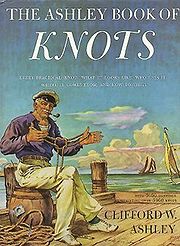
The Ashley Book of Knots
Encyclopedia


Encyclopedia
An encyclopedia is a type of reference work, a compendium holding a summary of information from either all branches of knowledge or a particular branch of knowledge....
of knot
Knot
A knot is a method of fastening or securing linear material such as rope by tying or interweaving. It may consist of a length of one or several segments of rope, string, webbing, twine, strap, or even chain interwoven such that the line can bind to itself or to some other object—the "load"...
s first published in 1944 by Clifford Warren Ashley. The culmination of over 11 years of work, it contains some 7000 illustrations and more than 3854 entries covering over 2000 different knots. The entries include instructions, uses, and for some knots, histories, and are categorized by type or usage. It remains one of the most important books on knots, as it is one of the most extensive, covering both good knots and bad, and noting which is which.
Use as a reference
Due to its scope and wide availability The Ashley Book of Knots has become a significant reference workReference work
A reference work is a compendium of information, usually of a specific type, compiled in a book for ease of reference. That is, the information is intended to be quickly found when needed. Reference works are usually referred to for particular pieces of information, rather than read beginning to end...
in the field of knotting. The numbers Ashley assigned to each knot can be used to unambiguously identify them. This is a useful function since knot names have evolved over time and there are many conflicting or confusing naming issues. Citations to Ashley numbers are usually in the form: "The Constrictor Knot
Constrictor knot
The constrictor knot is one of the most effective binding knots. Simple and secure, it is a harsh knot that can be difficult or impossible to untie once tightened. It is made similarly to a clove hitch but with one end passed under the other, forming an overhand knot under a riding turn...
(ABOK #1249)", "ABOK #1249" or even simply "#1249" if the context of the reference is clear or already established. The book title is also found abbreviated in the forms: TABOK, TABoK, or ABoK.
Some knots have more than one Ashley number due to having multiple uses or forms. For example, the main entry for #1249 is in the chapter on binding knots but it is also listed as #176 in a chapter on occupational knot usage.
The Ashley Book of Knots was published in the days of natural fiber
Natural fiber
Fibers or fibres are a class of hair-like materials that are continuous filaments or are in discrete elongated pieces, similar to pieces of thread. They can be spun into filaments, thread, or rope. They can be used as a component of composite materials. They can also be matted into sheets to...
cordage; the commentary on some knots may fail to address their behavior when tied in modern synthetic fiber
Synthetic fiber
Synthetic fibers are the result of extensive research by scientists to improve on naturally occurring animal and plant fibers. In general, synthetic fibers are created by forcing, usually through extrusion, fiber forming materials through holes into the air, forming a thread...
ropes.
Revisions and corrections have been added by International Guild of Knot Tyers
International Guild of Knot Tyers
The International Guild of Knot Tyers is a world-wide association for people with an interest in knots and knot tying. Officially established in 1982, the founding members were initially drawn together by the 1978 publication in The Times of an allegedly new knot, the Hunter's bend.The goals of...
. At least one knot, Hunter's bend
Hunter's bend
The Hunter's bend is a knot used to join two lines. It consists of interlocking overhand knots, and can jam under moderate strain. It is topologically similar to the Zeppelin bend.-History:...
(#1425A), was added in August 22 1993.
Further reading
- Clifford W. Ashley. The Ashley Book of Knots. Doubleday, New York. ISBN 0-385-04025-3
- Reprint: Doubleday, New York 1963–1979, ISBN 0-571-09659-X

